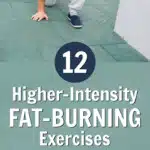Do you want a leaner, stronger, and more flexible physique? What follows is a higher-intensity, equipment-free workout that’s effective and fun. The workout includes 12 fat-burning exercises to help you torch calories, shed fat, and get into stellar shape.
You can do this workout once a week – and your fitness will reach the next level! I’ve included a video that should prove helpful.
A Quick Recap of What Circuit Training Is
Circuit Training combines diverse strength, fat-burning cardiovascular drills, and flexibility exercises into a single workout session.
In total, there are three circuits in this entire workout.
Here’s the primary way a circuit workout is done, based on whether you identify as a beginner, intermediate, or advanced-level athlete:
Beginner: If you’re new to circuit training, start with one round of each circuit, taking adequate rest between exercises and circuits. Begin with 10-12 reps per exercise, and as you become more comfortable, gradually increase the intensity and the number of reps.
Intermediate: For those with some experience, aim to complete two rounds of each circuit with minimal rest between exercises and a slightly higher rep range, typically 12-15 reps per exercise. This will intensify your workout and challenge your endurance.
Advanced: Seasoned athletes can push themselves further by completing three or more rounds of each circuit, minimizing rest periods as much as possible. Increase the intensity by performing 15-20 reps per exercise. This level of dedication will maximize calorie burn and enhance muscle endurance and strength.
Remember, regardless of your fitness level, it’s crucial to prioritize proper form and listen to your body. Adjust the number of circuits and reps to meet your specific goals and abilities as you progress. Stay consistent, and you’ll reap the rewards of improved health and fitness.

Circuit 1: Total Body Activation
The advantage of doing exercises that engage all the major muscle groups within the body is that they promote balanced strength development and – because they’re compound movements – they boost the metabolism:
- Toddler Tuck Jump – 10 reps
- This exercise might sound amusing, but it’s a fantastic way to boost your heart rate and engage your legs and core.
- Stand with your feet hip-width apart and jump while bringing your knees toward your chest, just like a toddler having a blast.
- Jump Squat – 15 reps
- Jump squats are an excellent way to strengthen your lower body and get your heart pumping.
- Start with your feet shoulder-width apart, perform a squat, and explode into a jump as you rise.
- Bear Crawl – 20 steps (10 forward, 10 backward)
- Bear crawls challenge your entire body, especially your core and shoulders.
- Get on all fours, lift your knees slightly off the ground, and move forward and backward. Keep your elbows bent so that your hips are above your shoulders.
- Lateral Step-Out Lunge – 12 reps per leg
- This exercise targets your legs and glutes while improving balance.
- Step forward into a lunge, then return to the starting position and step out to the side into another lunge.
Fat-Burning Circuit 2: Cardio and Core
Cardiovascular conditioning that includes core training can be enormously beneficial to the human body because it enhances overall endurance, promotes efficient oxygen utilization, strengthens the body’s central support system, and contributes to better posture and spinal health. This combination of benefits not only supports better athletic performance but also enhances daily functioning and reduces the risk of injuries:
- High-Knee Reverse Lunge – 15 reps per leg
- Elevate your heart rate and work your legs and glutes with this dynamic exercise.
- Perform a reverse lunge and then bring your knee up towards your chest before switching legs.
- Plank Jack – 20 reps
- Plank jacks are excellent for your core and cardio fitness.
- Start in a plank position on your elbows and jump your feet wide apart and back together.
- Lateral Bound – 12 reps per side
- Enhance your agility and leg strength with lateral bounds.
- Leap to the side, landing softly on one foot, then bound in the other direction.
- Beginners can catch their balance after each jump. Intermediates can catch their balance after every two jumps (see video). Do not roll an ankle! Proceed cautiously.
- Barrel Crawl – 20 steps (10 forward, 10 backward)
- This crawling exercise adds an element of fun while working your upper body and core.
- You crawl by turning your body over (like a barrel rolling – see video).

Circuit 3: Functional Strength
While isolation exercises will always be popular and have their place in your weekly fitness regimen, functional strength is still more important because it directly translates to improved daily activities, enhances stability, reduces the risk of injury, and fosters a well-rounded, adaptable physique that supports a healthier and more active lifestyle:
- Crab Crawl – 20 steps (10 forward, 10 backward)
- The crab crawl engages your triceps, shoulders, and core.
- Sit on the ground, lift your hips, and move forward and backward with your hands and feet.
- Lizard Crawl – 12 reps per leg
- Test your balance and strength with the lizard crawl.
- Begin in a push-up position and move one foot outside your hand, then switch sides. Unlike the bear crawl, where your hips are higher than your shoulders, with the lizard crawl, you want to keep your whole body as close to the ground as you can.
- Horse Walk – 20 steps
- The horse walk adds a unique twist to your workout, targeting your legs and core.
- Take wide steps forward, mimicking a horse’s gait.
- Lateral Traveling Ape – 12 reps per side
- This exercise challenges your coordination and strengthens your legs.
- Squat down and use your arms to propel yourself laterally, like an ape swinging through trees.
The genius of higher-intensity, fat-burning workouts is that they release endorphins, our body’s natural “feel-good” hormones, creating a positive and motivating feedback loop that not only elevates mood but also keeps us coming back for more, making our fitness journey enjoyable and sustainable.
Fat-Burning Finisher: Dead-Bug Exercise
The Dead Bug Exercise makes a great finisher for a circuit workout because it engages the core, improves stability, and helps cool down your body, promoting post-workout recovery and balance.
Here’s how to do the Dead Bug Exercise properly:
- Lie on your back with your arms extended toward the ceiling and your knees bent at a 90-degree angle.
- Lower one arm and the opposite leg toward the floor while pressing your lower back into the ground.
- Return to the starting position and repeat on the opposite side.
- Continue alternating sides while maintaining control and engaging your core throughout the movement.
I generally design my workouts keeping the mature athlete in mind. Special considerations for anyone over the age of 45 who is about to undertake an entirely new workout are to prioritize safety and gradual progression, seek medical clearance if needed, incorporate adequate warm-up and cool-down routines, focus on joint mobility and flexibility, and listen attentively to your body’s cues, allowing for necessary rest and recovery as you embark on your fitness journey.
Fat-Burning Simplified: How to Eat to Support This Workout
You might think this workout is pretty intense and wonder what you should eat afterward.
I encourage you to consult with your medical doctor or nutritionist, but I can give you a simplified version of how to get a firm body and the basic fat-burning principles involved.
Assuming you have some body fat that you’d like to lose, here’s something you can consider:
- Being in a calorie deficit makes you lose weight.
But wait. There’s more.
- Calorie deficit without lifting weights – and while not getting enough protein – can make you lose too much muscle, even if you’re losing some fat, too.
Never underestimate the importance of muscle tone. Muscle is what helps you look and feel good.
- Getting enough quality, lean protein helps you to retain muscle, especially in a calorie deficit.
That means the deficit probably needs to come from carbs or fats (since those are the only two macronutrients remaining).
What I’ve found helpful is to get most of my carbs from vegetables. They are so loaded with micronutrients and beneficial compounds. That is why you can have up to 9 loose cups of multicolored vegetables on an anti-inflammatory diet a day.
So, most of your deficit will probably come from fat. Might as well make it from saturated fat, specifically, since too much of it is not good for you anyway.
Conclusion: Higher-Intensity, Fat-Burning Workouts Are Invaluable
There you have it, a comprehensive workout designed for creative, health-conscious individuals over the age of 45.
These 12 high-intensity, equipment-free exercises offer diverse benefits, from cardiovascular improvement to increased strength and agility. Check out this video:
Remember, listening to your body and progressing at your own pace is crucial.
Consistency is key, so aim to incorporate this particular workout into your complete routine at least twice a month.
As you become more comfortable with the fat-burning exercises, consider increasing the number of reps or circuits for added challenge.
By staying committed and having fun with your workouts, you’ll be well on your way to torching calories, shedding fat, and achieving the vibrant health you deserve. Enjoy the journey, and embrace your newfound strength and vitality!
